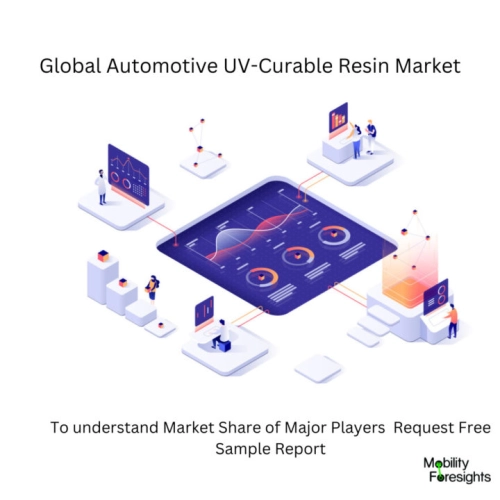
- Get in Touch with Us

Last Updated: Apr 25, 2025 | Study Period: 2023-2030
UV (ultraviolet) curable resins are substances that solidify monomers, oligomers, etc. by a chain polymerization reaction. A wide range of oligomers and polymer-type UV curable resins can be combined with diluents to provide a variety of performances since they each have unique properties like hardness, high gloss, and rapid curability.
Additionally, they are frequently used for optical and electrical/electronic materials where plastic substrates with poor heat resistance are used since it is possible to limit the amount of heating and curing time in the curing reaction.
They are also garnering interest as sustainable materials due to excellent energy savings and ease of producing ecologically friendly products that meet the criterion for solvent-free manufacturing.
Materials called UV-curable monomer resins are utilised for sealing applications because they may be quickly cured and polymerized by the energy from UV rays.
The market for UV curable resins should increase as a result of advancing technology and a desire for high-performance resins. UV (ultraviolet) curable resins are substances that may solidify monomers, oligomers, etc. by a chain polymerization reaction.
Due to its various benefits in headlight applications, UV curing is widely employed in the automotive sector. Vehicle headlamps are effectively cured using our UV curing devices and UV (ultraviolet) curable polyurethanes. Against moisture, dust, and chemicals, this UV procedure provides excellent defence.
Monomers, oligomers, photopolymerization catalysts, and other ingredients make up UV curable resin. The photoinitiator initiates a chemical process when exposed to ultraviolet light (UV light), which enables it to join independent oligomers and monomers into a more complicated chain. They are referred to as polymers.
A UV coating (or more generally, a coating that has been exposed to radiation to cure it) is a surface treatment that either uses ultraviolet radiation to cure it or shields the underlying material from its damaging effects.
Epoxy resin cures naturally but UV resin can only cure when exposed to UV rays. 1mm is the maximum layer thickness. On the other hand, epoxy resin permits castings with up to 5 cm of layer thickness. Only smaller areas can use UV resin because it always needs a UV lamp to cure.

The Global Automotive UV-curable Resin market accounted for $XX Billion in 2022 and is anticipated to reach $XX Billion by 2030, registering a CAGR of XX% from 2023 to 2030.
New UV-curable resins for the automotive industry launched by Allnex. For formulators, they offer design flexibility so they can tailor their formulations for various end uses that call for bending, stretching, or shaping in shape. With a UV-curable solution, this group of cutting-edge resins bridges the performance gap between thermoplastics and thermosets.
For formulators, they offer design flexibility so they can tailor their formulations for various end uses that call for bending, stretching, or shaping in shape. According to the requirements of the tests for automobile interiors, these resins also exhibit exceptional resistance to abrasion, DEET, sunscreen, hand lotion, and all three.
It is extraordinarily resilient and strong. From light to deep draws, post UV cure shaping is permitted (2.5 cm).
For outdoor use, it has good weatherability. Good abrasion resistance and the ability to heal minor scratches on its own. Following various chemical testing, it maintained its gloss exceptionally well.
They are a perfect option for post cure manipulation applications, for in-mould labelling embellishment, and for paint protection film applications due to their high hardness, chemical resistance, and flexibility features.
More people are using UV LED curing, which is still expanding quickly in the radiation-curable sector. UV LED technology has advanced significantly in recent years and can now provide constant and acceptable dosage and intensity at a cost competitive with traditional UV curing systems.
Historically, medium pressure mercury vapour lamp technology dominated this industry. Due to this, UV LED cure is now used in a variety of applications, such as fibre optic coatings, printing inks, wood coatings, and graphic coatings.
Despite all of these benefits, the ability to match the adhesive, coating, and ink compositions to the precise UV LED lamp wavelengthsâmost frequently 365 nm and 395 nmâis essential for the successful deployment of UV LED curing.
The photo initiator is frequently regarded as the formulation's most crucial decision and is selected in accordance with these spectrum outputs. However, the consideration of substances that can increase the system's overall reactivity is also significant.
| Sl no | Topic |
| 1 | Market Segmentation |
| 2 | Scope of the report |
| 3 | Abbreviations |
| 4 | Research Methodology |
| 5 | Executive Summary |
| 6 | Introduction |
| 7 | Insights from Industry stakeholders |
| 8 | Cost breakdown of Product by sub-components and average profit margin |
| 9 | Disruptive innovation in the Industry |
| 10 | Technology trends in the Industry |
| 11 | Consumer trends in the industry |
| 12 | Recent Production Milestones |
| 13 | Component Manufacturing in US, EU and China |
| 14 | COVID-19 impact on overall market |
| 15 | COVID-19 impact on Production of components |
| 16 | COVID-19 impact on Point of sale |
| 17 | Market Segmentation, Dynamics and Forecast by Geography, 2023-2030 |
| 18 | Market Segmentation, Dynamics and Forecast by Product Type, 2023-2030 |
| 19 | Market Segmentation, Dynamics and Forecast by Application, 2023-2030 |
| 20 | Market Segmentation, Dynamics and Forecast by End use, 2023-2030 |
| 21 | Product installation rate by OEM, 2023 |
| 22 | Incline/Decline in Average B-2-B selling price in past 5 years |
| 23 | Competition from substitute products |
| 24 | Gross margin and average profitability of suppliers |
| 25 | New product development in past 12 months |
| 26 | M&A in past 12 months |
| 27 | Growth strategy of leading players |
| 28 | Market share of vendors, 2023 |
| 29 | Company Profiles |
| 30 | Unmet needs and opportunity for new suppliers |
| 31 | Conclusion |
| 32 | Appendix |